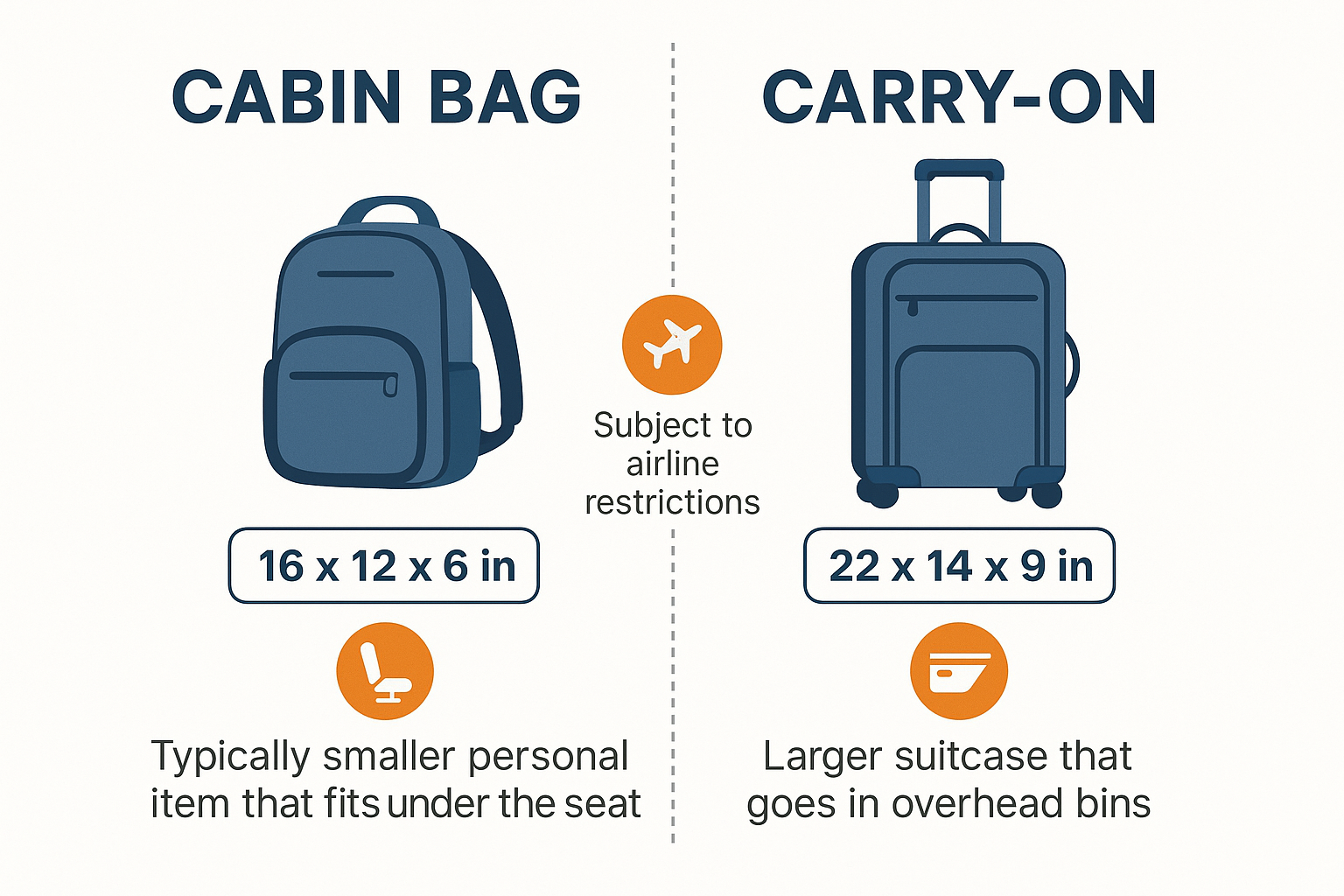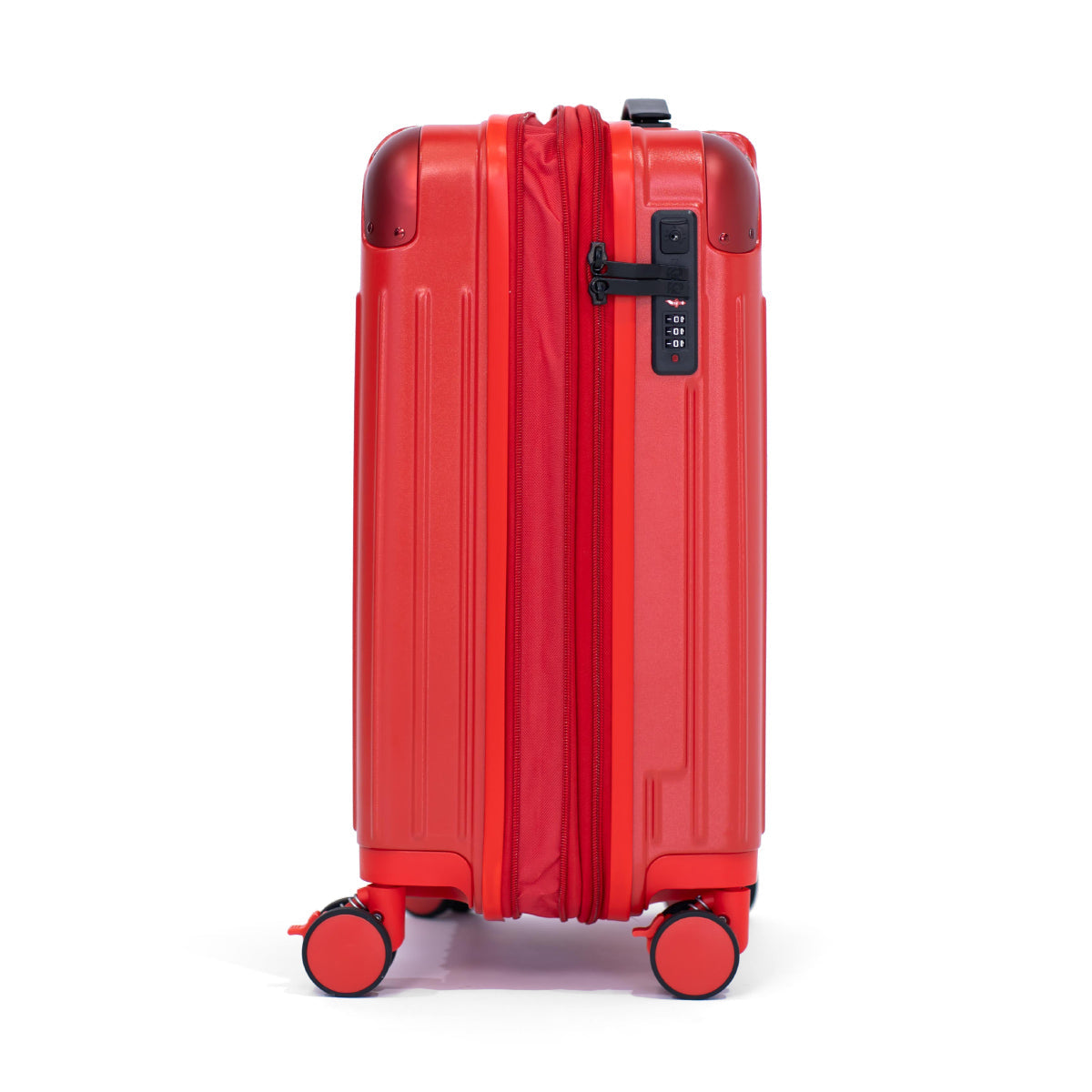
Cabin Bags vs. Carry-On Luggage: What’s the Difference?
You are not alone in thinking that baggage regulations are baffling when you book a flight. Airlines are fond of tossing around a cabin bag and carry-on luggage. On the face of it, they appear to mean the same thing - after all, both are bags that you carry onto the plane with you. However, peel back the surface and the variations can actually influence your packing, your comfort and at times even your wallet.

So, what's the real deal? We will explain it in ordinary words so that you know what to expect next time you fly.
What Is a Cabin Bag?
A cabin bag is usually the smaller item you can bring into the airplane cabin. Think of it as your personal bag that fits under the seat in front of you. It could be:
-
A backpack
-
A laptop bag
-
A tote or handbag
-
A small duffel
The cabin bags are not usually intended to be placed in the overhead locker, but beneath your seat. They are the perfect size to take all the things you will require on the trip: your phone, headphones, snacks, passport, laptop, or a sweater.
There are some airlines where the size of your cabin bag has to be very precise, but some are more lenient.
What Is Carry-On Luggage?
Carry-on luggage is the slightly larger bag you’re allowed to place in the overhead locker. This is the bag that holds your clothes, shoes, and anything else you didn’t want to check in.
Most carry-ons are small suitcases with wheels (often called spinner bags). Some are sleek duffels or structured backpacks that meet the airline’s size limits.
Carry-on luggage gives you more room than a cabin bag, but it still has restrictions. For many airlines, the standard limit is around 55 cm x 35 cm x 23 cm (but always check your airline’s website, as rules vary).
So, Are They the Same Thing?
Not quite. Here’s the simple distinction:
-
Cabin bag = smaller personal bag (under the seat).
-
Carry-on luggage = larger bag (overhead locker).
On most flights, you’re allowed to bring both a cabin bag and a carry-on. But some budget airlines only let you bring a cabin bag unless you pay extra. That’s why the confusion happens: the terms overlap depending on where you’re flying and which airline you’re on.
Why the Difference Matters
At first, it might feel like a small detail, but understanding the difference can save you a lot of stress at the airport. Here’s why:
-
Airline Fees
If you think your carry-on suitcase counts as your free cabin bag, you might be hit with surprise fees. Budget airlines are especially strict about this. -
Packing Strategy
When purchasing a single bag (a cabin bag), you will be forced to pack ultra-light (only essentials). With one on top of the other, you can even evenly distribute your weight: your laptop and other valuable items in a cabin bag, your clothes and heavier items in a carry-on. -
Comfort During the Flight
A snack, book or hoodie in your under-seat cabin bag will save you the trouble of having to get in the aisle and disturb everyone to open the overhead locker
How to Pack Both Smartly
On the rare occasions when you get a cabin bag and a carry-on, there is an easy way to separate them:
-
Cabin Bag: In this bag are things that you will want to have right at your fingertips: wallet, passport, phone charger, headphones, snacks, book, medication, laptop, and perhaps a small toiletry pouch.
-
Carry-On Luggage: You need to pack up clothes, shoes, toiletries, and all these things that you will not need until you reach where you are going.
This will allow your necessities to remain with you, and your larger ones to be safely stored over your head.
The Airline Factor
This is where it becomes a little complicated: every airline has its own meaning of the bag that fits into the cabin and the bag that is considered a carry-on.
-
Full-service airlines (such as Qantas, Virgin Australia or Singapore Airlines) typically permit a cabin bag and a carry-on.
-
The cheapest airlines (such as Jetstar, Ryanair, or AirAsia) will usually make a cabin bag the only add-on to your base fare. A wheeled carry-on will cost you additional money.
That is why when making bookings, it is important to read the fine print. Not only the bag itself, but also no more unexpected bills.
The Rise of Stylish, Compact Luggage
As airlines tighten, luggage brands are beginning to make smarter bags. The most popular carry-ons today are sleek enough to meet the airline regulations but nice enough to look like they are part of your wardrobe.
A perfect example is brands such as Koora. You can easily fit the expandable carry-on in overhead lockers; however, when you require some extra room, the carry-on can be extended without violating airline regulations. It is recyclable, strong enough to carry through to the end of the day, and smooth enough to help you look presentable at the airport. Add a small cabin bag--such as a backpack or tote--and you have a travel outfit that fits anywhere.
Travel Scenarios: Which Bag Works Best?
Still not sure how to decide? Let’s look at a few real-life travel scenarios:
-
Weekend getaway: A cabin bag might be enough. Toss in a change of clothes, toiletries, and your essentials.
-
Business trip: You’ll want both — a cabin bag for your laptop and documents, and a carry-on for your work outfits.
-
International vacation: Definitely both. Cabin bag for valuables, carry-on for everything else.
-
Budget airline flight: If your ticket only includes a cabin bag, be prepared to pack light — or pay extra for carry-on space.
Tips for Travelling Lighter
Regardless of the bag you are carrying, it is better to travel light. Here are some simple tricks:
-
Roll clothes rather than folding--saves space and keeps clothes wrinkle-free.
-
Keep two pairs of shoes, and put on the heaviest pair on the aeroplane.
-
Use neutral colours - simplify mixing and matching.
-
Buy quality luggage - a light bag (such as a carry-on eco bag by Koora) will leave you with more space in your bag without worrying about airline baggage fees.
Final Thoughts
Cabin luggage and carry-on luggage are not similar, but they are both needed in different ways. Your cabin bag is your under-seat companion; everything you might need whilst on board will be within reach in the cabin bag. The carry-on is your small yet powerful suitcase and has just enough space to carry a few clothes and travel necessities without having to incur the inconvenience of carrying your luggage around.
Knowing the difference will save you the hassle of packing, paying unexplained charges and travelling more comfortably. And with chic, eco-friendly choices such as Koora, your bags can be good to look at, good to feel, and good to fit - under the chair or in the overhead carrier.
The next time you board an aircraft, you can use this easy formula that works: place your cabin bag under the seat, use a carry-on locker, and sit in the window seat, all set to take off.



Leave a comment
This site is protected by hCaptcha and the hCaptcha Privacy Policy and Terms of Service apply.